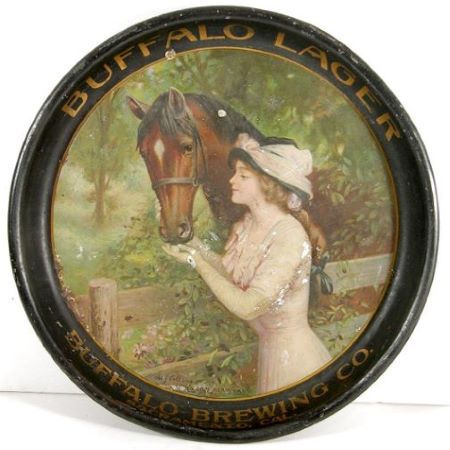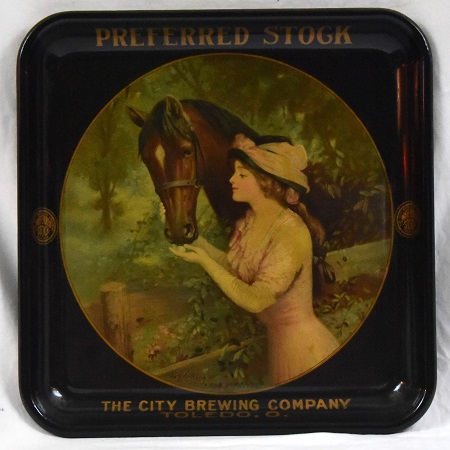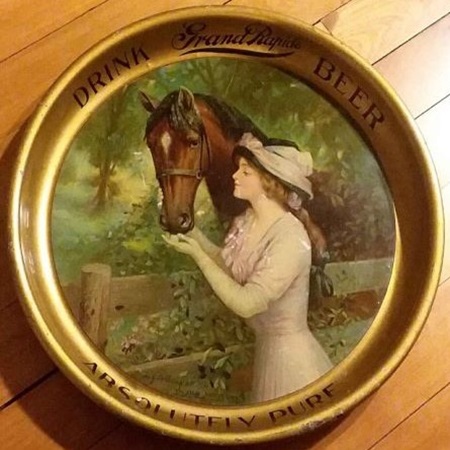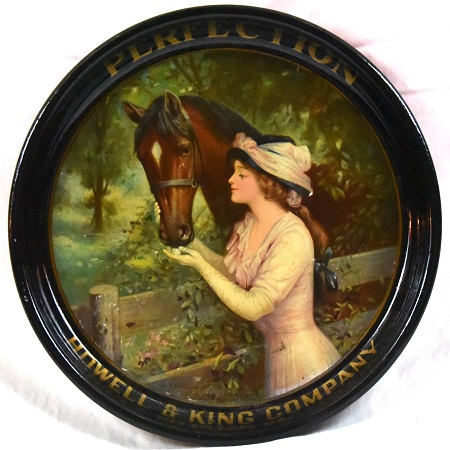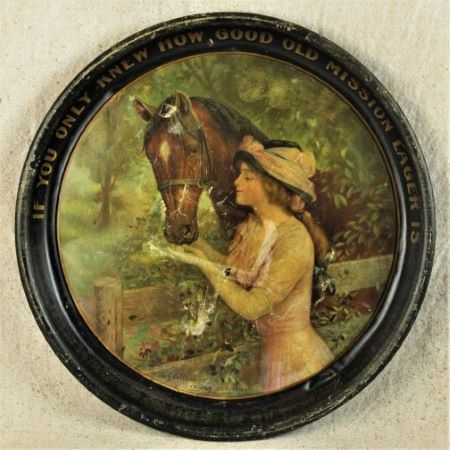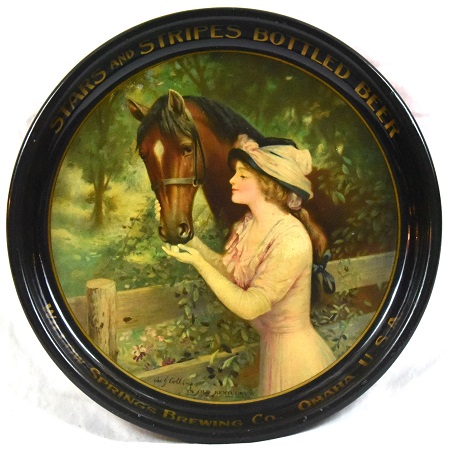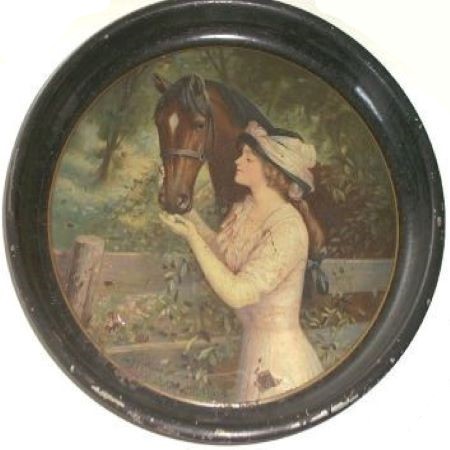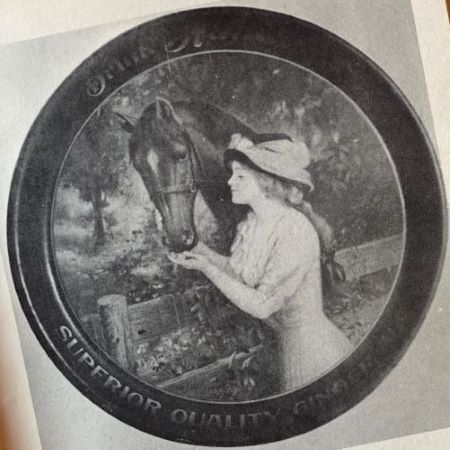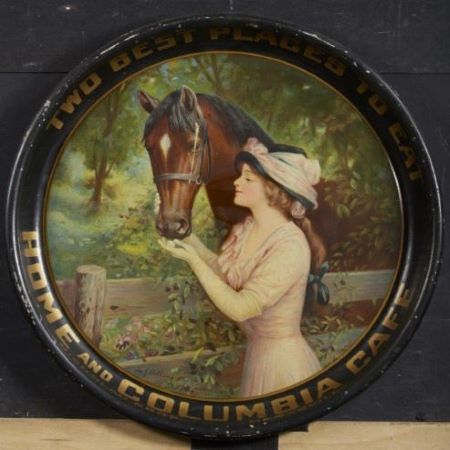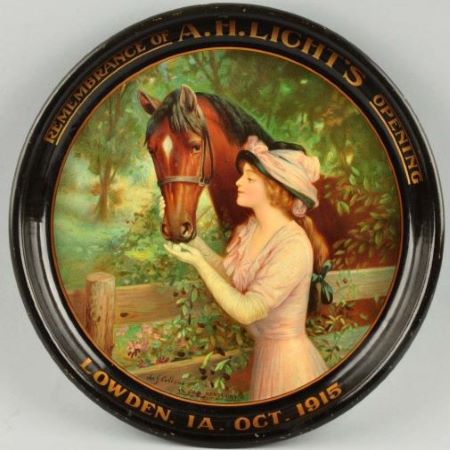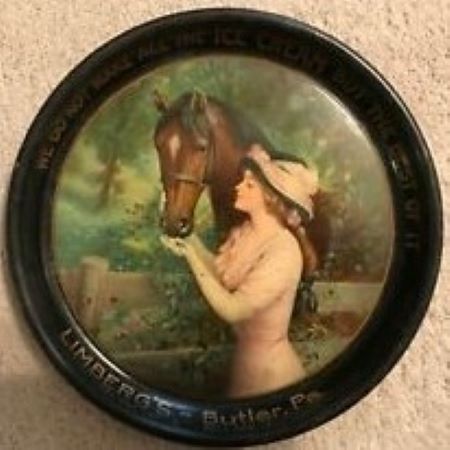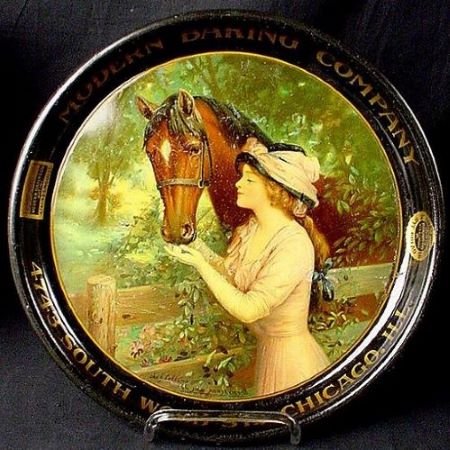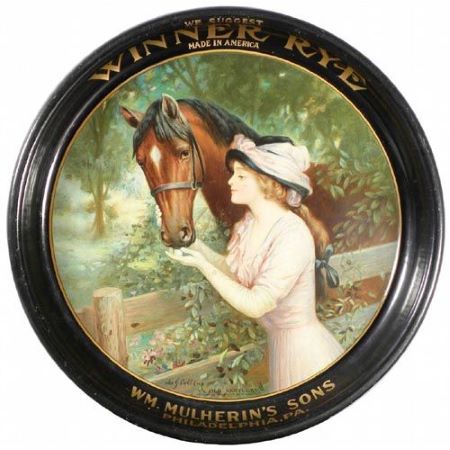The 'Stock' Exchange
American Art Works No. 127 "In Old Kentucky"
American Art Works No. 127 "In Old Kentucky"
Date: 1910 to 1920
Size: 13" & 13.5" x 13.5"
Type: Pie
Scarcity: Common
Value: $$$ to $$$$
Condition & Brewer Dependent
Size: 13" & 13.5" x 13.5"
Type: Pie
Scarcity: Common
Value: $$$ to $$$$
Condition & Brewer Dependent


General
No. 127 "In Old Kentucky" is the second Meek/American Art Works design to feature an attractive woman and a horse, following several years after “Good Friends” (No. 80). Coshocton competitor H. D. Beach also had a woman and horse design “Friends” (No. 11-B) a few years earlier. However, unlike the posed portrait of No. 80, this design captures a candid moment of interaction between the woman and the horse. This is one of the few designs where the subject does not appear conscious of being viewed.
Kentucky has long had a reputation for beautiful women and fast horses, and while there are lots of quotes about women and horses, we couldn’t find the specific origins of this expression. Kentucky is also famous for bourbon. Both horses and bourbon thrive in the area due to one common denominator: the natural limestone-filtered water that flows throughout Kentucky’s 40,407 square miles. As settlers pushed further and further west in the mid-18th century, those with previous distilling knowledge and those with equestrian experience recognized Kentucky’s wealth of limestone and mineral-based water. This water produces strong bones in horses and quality whiskey free from impurities. So, many decided to settle in the area and either distill whiskey or breed and raise thoroughbreds. Thoroughbred racing was just ramping up on the East Coast during this time, and many farms throughout Kentucky would hold private races for those who lived nearby. Those small-town tracks eventually led to bigger and bigger courses, attracting people from near and far.
No. 127 "In Old Kentucky" is the second Meek/American Art Works design to feature an attractive woman and a horse, following several years after “Good Friends” (No. 80). Coshocton competitor H. D. Beach also had a woman and horse design “Friends” (No. 11-B) a few years earlier. However, unlike the posed portrait of No. 80, this design captures a candid moment of interaction between the woman and the horse. This is one of the few designs where the subject does not appear conscious of being viewed.
Kentucky has long had a reputation for beautiful women and fast horses, and while there are lots of quotes about women and horses, we couldn’t find the specific origins of this expression. Kentucky is also famous for bourbon. Both horses and bourbon thrive in the area due to one common denominator: the natural limestone-filtered water that flows throughout Kentucky’s 40,407 square miles. As settlers pushed further and further west in the mid-18th century, those with previous distilling knowledge and those with equestrian experience recognized Kentucky’s wealth of limestone and mineral-based water. This water produces strong bones in horses and quality whiskey free from impurities. So, many decided to settle in the area and either distill whiskey or breed and raise thoroughbreds. Thoroughbred racing was just ramping up on the East Coast during this time, and many farms throughout Kentucky would hold private races for those who lived nearby. Those small-town tracks eventually led to bigger and bigger courses, attracting people from near and far.
Confirmed Brewer used Stock Trays
Non-Beer Related & Non-Tray Uses
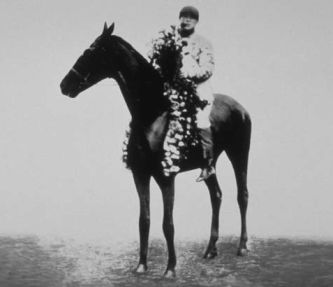
Of course, the most famous horse race in Kentucky is the Kentucky Derby, started in 1875 and held annually in Louisville, Kentucky at Churchill Downs in early May. Churchill Downs was established by Meriwether Lewis Clark Jr. grandson of the William Clark of the Lewis & Clark expedition. Originally a 1 ½ mile race it was shortened to its current 1 ¼ mile length in 1902. And while there isn’t a clear connection, the woman’s attire is consistent with the elegant outfits lavishly accessorized with large, elaborate hats that are traditional at the Derby. We attempted to correlate the image of the horse with Worth (from Kentucky naturally), the winner of the 1912 Kentucky Derby but the single picture we found was in profile and inconclusive. Worth’s winning time was a pedestrian 2:09 (most current races are around 2:01-2:04) but occurred on a muddy track. The horse was put down later that same year after sustaining serious injuries in another race.
The design is signed Chas J Collins. The only artist active during this timeframe we could find was Charles Jerome Collins (1851-1915), an English painter best known for landscape and cattle paintings based in the Scottish Highland, Wales and Cornwall. He seems like an unlikely candidate to be the creator of this design although we did find some evidence of horses in his works.
Sahling does not have an entry in his workbook for this design. Although he does have designs No. 125 and No. 126 listed in May of 1912 (the month the Derby is run), the inconsistency of sequencing at this point does not serve as any indication that No. 127 was developed after the Derby was run so we cannot use this to substantiate the horse’s identify either.
Shape & Rim and Advertising Placement
The vast majority of trays with this design are concave pies with a smattering of square trays. We have never seen a sign with this design and only have an unsubstantiated reference to a tip tray version. Rims are usually black with gold advertising text, although gold rims with black text are known (Grand Rapids Brewing). We do not recall seeing any examples with advertising on the face of the tray.
Hager & Price
Hager does not discuss this design but includes in both his date of introduction table and his catalog. This design didn’t seem to be particularly popular with brewers and only a handful used it; prices tend toward the low triple digits. Surprisingly, prices for non-brewers fair better than others designs in the high double or low triple digits (but less than brewery examples). Strangely, we have never encountered an example advertising Kentucky’s other famous product, bourbon.
Sahling does not have an entry in his workbook for this design. Although he does have designs No. 125 and No. 126 listed in May of 1912 (the month the Derby is run), the inconsistency of sequencing at this point does not serve as any indication that No. 127 was developed after the Derby was run so we cannot use this to substantiate the horse’s identify either.
Shape & Rim and Advertising Placement
The vast majority of trays with this design are concave pies with a smattering of square trays. We have never seen a sign with this design and only have an unsubstantiated reference to a tip tray version. Rims are usually black with gold advertising text, although gold rims with black text are known (Grand Rapids Brewing). We do not recall seeing any examples with advertising on the face of the tray.
Hager & Price
Hager does not discuss this design but includes in both his date of introduction table and his catalog. This design didn’t seem to be particularly popular with brewers and only a handful used it; prices tend toward the low triple digits. Surprisingly, prices for non-brewers fair better than others designs in the high double or low triple digits (but less than brewery examples). Strangely, we have never encountered an example advertising Kentucky’s other famous product, bourbon.
Click the Picture to Return to Meek & Beach Stock Catalog Page
